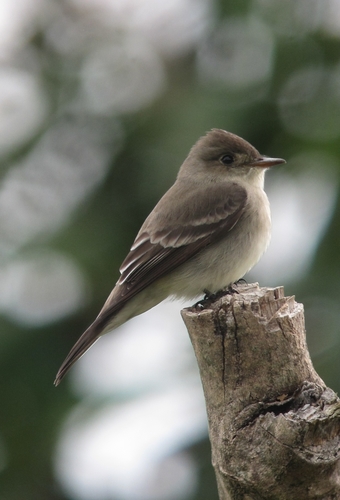
Eastern Wood-pewee
The Eastern Wood-pewee is a small, inconspicuous flycatcher of eastern North American forests. Known for its clear, whistled "pee-a-wee" song, it plays a vital role in controlling insect populations within its woodland habitat. While not brightly colored, its subtle beauty and distinctive vocalizations make it a cherished, if often overlooked, part of the forest soundscape. It holds no particular cultural significance, though its easily recognizable song is a common sound to those familiar with North American forests.
13-15 cm
Length
23-26 cm
Wingspan
Least Concern
Conservation Status
Distribution
Breeds across eastern North America, from southeastern Canada south to Florida and the Gulf Coast, and west to the Great Plains. Migrates through Central America and winters in northern South America, primarily in countries like Colombia, Venezuela, Ecuador and Peru.
Lifespan
Up to 7 years in the wild, though average lifespan is likely shorter.
Eastern Wood-pewee's Habitat
Habitat Types
Deciduous forests, Mixed forests, Forest edges, Wooded swamps
Climate Zones
Temperate, Subtropical
Adaptations
Prefers areas with a relatively open understory, allowing for easy flight and foraging among the trees. Their muted coloration provides camouflage within the dappled light of the forest.
Variations
No recognized subspecies.
Appearance
Breeding Plumage
Plumage is similar year-round.
Seasonal Feather Changes
No significant seasonal variation.
Sex Based Plumage Differences
Males and females are visually indistinguishable.
Notable Features
Olive-gray upperparts, Whitish underparts with a slight olive wash on the breast, Two pale wingbars, Lacks a prominent eye-ring
Diet and Feeding
Primary Foods
Flying insects, Beetles, Flies, Moths, Wasps
Foraging Behavior
Sallies out from a perch to catch insects in mid-air, often returning to the same perch. Also gleans insects from foliage.
Specializations
Excellent aerial maneuverability for capturing flying insects.
Seasonal Diet Variations
Diet is primarily insectivorous year-round, though the specific types of insects consumed may vary based on availability.
Behavior
Social Structure
Generally solitary or in pairs during the breeding season. May form loose flocks during migration.
Communication
Distinctive "pee-a-wee" song, A rapid, chattering "pip-pip-pip" call
Migration
Long-distance migrant, traveling at night. Migrates singly or in small groups.
Territorial or Group Behaviors
Males are territorial during the breeding season, defending their territory with song and chases.
Conservation
Threats
Habitat loss and fragmentation (both breeding and wintering grounds), Pesticide use (reducing insect prey), Collisions with buildings and other structures
Protection Programs
Conservation of forested habitats, Efforts to reduce pesticide use
Local National Laws
Protected under the Migratory Bird Treaty Act in the United States.
Population Trend
Stable or slightly declining in some areas.
Population Estimates
Global population estimated at 9.5 million (Partners in Flight).
Interesting Facts
They often reuse the same nest site year after year.
This site fidelity is common in many bird species.
They can be difficult to spot despite their loud song.
Their drab plumage and habit of perching high in trees make them easy to overlook.
The Eastern Wood-pewee is one of the latest spring migrants to arrive on its breeding grounds.
This may be related to the emergence of their insect prey.
Faqs about Eastern Wood-pewee
What is the difference between an Eastern Wood-pewee and a phoebe?
Pewees have wingbars and lack the tail-wagging behavior of phoebes. Their songs are also very different.
Where can I see an Eastern Wood-pewee?
Look for them in deciduous or mixed forests during the breeding season. Listen for their distinctive song.
Do Eastern Wood-pewees visit bird feeders?
No, they are primarily insectivorous and do not typically visit feeders.
Copyright @ Nature Style Limited. All Rights Reserved.
 English
English